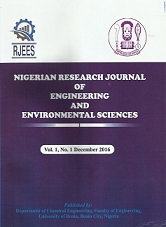Assessment of the Impact of Discharging Industrial Effluent on the Physio-chemical and Heavy Metal Parameters of the New Calabar River
Authors: Ikebude, C.F.
DOI Info: http://doi.org/10.5281/zenodo.14565546
ABSTRACT
This study investigated the impact of effluent discharge on the physicochemical parameters of the New Calabar River. A total of 24 samples were collected—12 for physicochemical analysis and 12 for heavy metals—from the surrounding industrial aquatic environment. The samples were placed in a light-proof box to protect them from direct sunlight and transported to the laboratory for analysis. The physicochemical parameters included dissolved oxygen (DO), total dissolved solids (TDS), pH, electrical conductivity (EC), and heavy metals such as zinc (Zn), copper (Cu), nickel (Ni), cadmium (Cd), and lead (Pb). The DO concentration in the river mixture ranged from 0.3 to 1.3 mg/L, with an average of 0.60 mg/L, indicating a serious threat to aquatic life. The TDS values ranged from 53.68 to 267.05 mg/L, with a mean of 156.78 mg/L, where the highest TDS was observed at E5 and the lowest at E3. Calcium concentrations varied from 0 to 8.08 mg/L, averaging 2.075 mg/L, while sodium levels ranged from 36.58 to 83.77 mg/L, with a mean of 65.92 mg/L. The study revealed that the river water is septic due to increased industrial discharge of organic effluents. Zinc was identified as the most dominant heavy metal, with values ranging from 0.2 to 1 mg/L. The river water will require tertiary treatment before it can be used for domestic and municipal purposes.
Affiliations: Department of Civil Engineering, Faculty of Engineering, University of Port Harcourt, Rivers State, Nigeria.
Keywords: Effluent, River, Sample, Concentration, Maximum Value, Minimum Value
Published date: 2024/12/30









